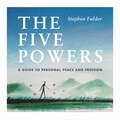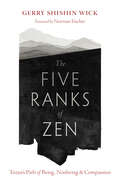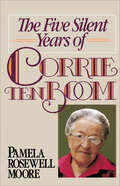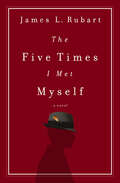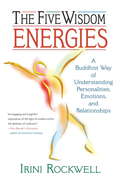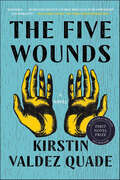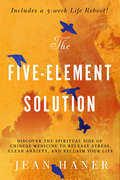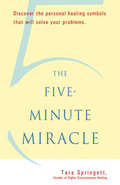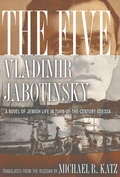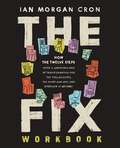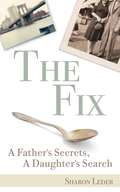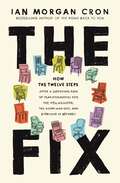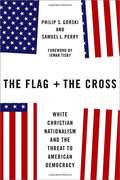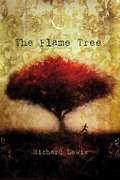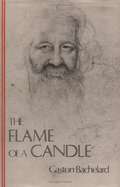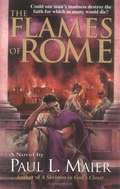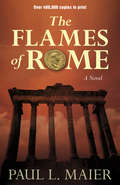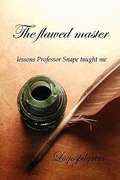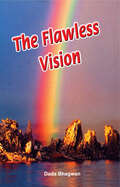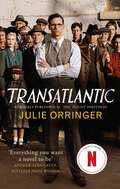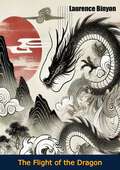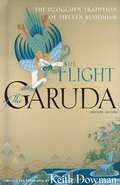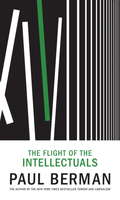- Table View
- List View
The Five Powers: A guide to personal peace and freedom
by Stephen FulderMINDFULNESS + TRUST + ENERGY + SERENITY + WISDOMIt can all feel a bit too much. We find ourselves occupied, morning to night, with reacting, responding and coping with uncontrollable and often challenging circumstances. How can we rise above stress, anxiety and frustration? How do we perform a restart? Is it possible to radically transorm our daily life? How can we invite deeping meaning and freedom into our lives? For many, the gateway to the Buddhist teachings is Mindfulness. And Mindfulness is indeed one of the Five Powers that are regarded as the original teachings of the Buddha: 1. Trust 2. Energy3. Mindfulness4. Serenity5. WisdomWhat do the Five Powers feel like on our journey and how do they help us climb? Any transformation begins with Trust, a leap of faith, letting go of the sides and getting into the stream of life, no longer trying to control where it will take us but instead experiencing every moment. We need Energy to overcome resistance and keep going, to be energised instead of drained by life. And of course Mindfulness brings our awareness into where we are on the path, to notice the rocks and flowers along the way, the important stuff. Inner freedom expands, amplified by Serenity. We focus on what is right in front of us, we listen intently, we are patient with life. And Wisdom provides our inner knowing, our compass. The Five Powers work together to help us on our way to remembering why we are here, to let go of our stories and grasp the big picture - we see how the world and ourselves make each other. Life lives through us. The Five Powers is the perfect guide and inspiration for those seeking happiness, contentment, and love in daily life. Its teachings will help readers to dance with the unexpected, to embrace the everyday and climb the mountain.(p) 2019 Octopus Publishing Group
The Five Ranks of Zen: Tozan's Path of Being, Nonbeing, and Compassion
by Gerry Shishin WickA comprehensive and accessible guide to the Five Ranks, the pinnacle teaching of Zen Buddhism pointing to the path to true freedom.The great Japanese Zen master Hakuin exclaimed, &“How priceless is the merit gained through the step-by-step practice of the Five Ranks of Master Tozan!&” Hakuin here refers to a teaching created by the Chinese Buddhist master Dongshan, known in Japanese as Zen Master Tozan, which is honored and studied in both Soto and Rinzai schools of Zen and is a gem of the classical Zen tradition. The ranks—pithy, provocative titles followed by Tozan&’s brief poetic commentaries—serve as guides to a radical exploration of the experience of relative and absolute reality, the interpenetrating &“Two Truths&” of Mahayana Buddhism.In The Five Ranks of Zen, American Zen teacher Shishin Wick offers an accessible entry point to each of the ranks, which Tozan created in two formulations: the first and better-known is the Five Ranks of the Relative and the Absolute; while the second set, called the Sequence of Merit, is an abbreviated form of the Ten Oxherding Pictures, a traditional formulation of the Zen spiritual journey. Wick presents multiple translations and offers commentary on the ranks&’ titles and on Tozan&’s renowned verses, as well as offering guidance on these teachings&’ application in contemporary life and Zen practice. He emphasizes that, to truly plumb the depths of Tozan&’s teachings, you must treat these teachings as Zen koans and make a thorough investigation using your entire body.
The Five Silent Years of Corrie Ten Boom
by Pamela Rosewell MoorePam Roswell Moore had her doubts when she interviewed to be companion of the much-loved author Corrie ten Boom. Corrie's bestselling book The Hiding Place, which recounted how she and her family had hidden Jews during World War II in Holland until their betrayal and arrest by the Nazis, had launched for Corrie a worldwide ministry of travel and speaking. Awed by the spiritual challenge this companionship posed, Pam wondered how she could keep up with the energetic 83-year-old.But God knit a strong bond between the young Englishwoman and the remarkable Dutch evangelist. Then Corrie suffered a stroke. Hospitalization followed; physical therapy; then long, loving hours at home. Corrie regained a little mobility for a time--until the next strokes hit. She never regained her speech. But the ministry that had touched millions continued as Corrie communicated through her eyes, through elaborate guessing games with those around her, through silent intercession for people God brought to mind.For those five silent years of imprisonment, Corrie's spiritual depth offered mute testimony to her ongoing trust in her heavenly Father. The details of these years will move all who loved Corrie ten Boom. They will encourage those involved with the elderly or handicapped--and those who are themselves bedridden--that God is at work mysteriously in and through even the most incapacitated. This book attests to the truth Corrie loved so dearly: that, in spite of everything else, Jesus is always Victor.
The Five Times I Met Myself: A Novel
by James L. RubartA troubled, middle-aged family man meets his younger self in a dream and attempts to change his life in this inspirational novel.“If you think fiction can’t change your life and challenge you to be a better person, you need to read The Five Times I Met Myself.” —Andy Andrews, New York Times–bestselling author of How Do You Kill 11 Million People, The Noticer, and The Traveler’s GiftWhat if you met your twenty-three-year-old self in a dream? What would you say?Brock Matthews’ once promising life is unraveling. His coffee company. His marriage.So when he discovers his vivid dreams—where he encounters his younger self—might let him change his past mistakes, he jumps at the chance. The results are astonishing, but also disturbing.Because getting what Brock wants most in the world will force him to give up the one thing he doesn’t know how to let go . . . and his greatest fear is that it’s already too late.“A powerfully redemptive story with twists and turns that had me glued to every page. With a compelling message for anyone who longs to relive their past, The Five Times I Met Myself is another James L. Rubart masterpiece.” —Susan May Warren, bestselling author of the Christiansen Family series
The Five Wisdom Energies: A Buddhust Way of Understanding Personalities, Emotions, and Relationships
by Irini RockwellThis book invites us to celebrate our strengths and work with our weaknesses by learning to identify and utilize five basic personal styles or energies. Written in a playful and accessible way, this is the first general-audience book on a Tibetan Buddhist system known as "the five buddha families"--an insightful way of understanding human behavior and promoting personal growth. Each of the five wisdom energies is associated with particular ways of perceiving and interacting with the world and also with particular colors, elements, senses, seasons, and times of day. With easy, fun, and engaging exercises and stories, Irini Rockwell shows us how to identify which energies are active in our lives, and how we can work with them in any situation to improve self-awareness, communication, and creative expression. According to the Tibetan Buddhist tradition, each of us has one or two dominant energies, but these can shift and change over time, and we can manifest different energies in different areas of our lives. Each of the five energies has its unique wisdom, but also its neurotic tendencies. By learning to recognize which energies we possess--and which are present in those around us--we can learn to relax and appreciate our natural traits and those of others, and we can move away from our neuroses toward the wisdom-aspects of our character.
The Five Wounds: A Novel
by Kirstin Valdez QuadeWinner of the 2021 Center for Fiction First Novel Prize Winner of the 2022 Rosenthal Family Foundation Award Finalist for the 2022 Andrew Carnegie Medal for Excellence in Fiction • Finalist for the 2022 PEN/Hemingway Award for Debut Novel • Finalist for the 2022 Aspen Words Literary Prize • Finalist for the 2022 Lambda Literary Award for Lesbian Fiction • Finalist for the 2022 Mark Twain American Voice in Literature Award One of NPR's Best Books of the Year • A Publishers Weekly and Library Journal Best Book of the Year in Fiction • A Kirkus Reviews Best Fictional Family of the Year • A Booklist Top Ten Book-Group Book of the Year and Top Twenty-First Century First Novels, So Far • A Goodreads Choice Awards Best Debut Novel Nominee From an award-winning storyteller comes a stunning debut novel about a New Mexican family’s extraordinary year of love and sacrifice. "Masterly…Quade has created a world bristling with compassion and humanity. The characters and the challenges they face are wholly realized and moving; their journeys span a wide spectrum of emotion and it is impossible not to root for [them]." —Alexandra Chang, New York Times Book ReviewIt’s Holy Week in the small town of Las Penas, New Mexico, and thirty-three-year-old unemployed Amadeo Padilla has been given the part of Jesus in the Good Friday procession. He is preparing feverishly for this role when his fifteen-year-old daughter Angel shows up pregnant on his doorstep and disrupts his plans for personal redemption. With weeks to go until her due date, tough, ebullient Angel has fled her mother’s house, setting her life on a startling new path.Vivid, tender, funny, and beautifully rendered, The Five Wounds spans the baby’s first year as five generations of the Padilla family converge: Amadeo’s mother, Yolanda, reeling from a recent discovery; Angel’s mother, Marissa, whom Angel isn’t speaking to; and disapproving Tíve, Yolanda’s uncle and keeper of the family’s history. Each brings expectations that Amadeo, who often solves his problems with a beer in his hand, doesn’t think he can live up to.The Five Wounds is a miraculous debut novel from a writer whose stories have been hailed as “legitimate masterpieces” (New York Times). Kirstin Valdez Quade conjures characters that will linger long after the final page, bringing to life their struggles to parent children they may not be equipped to save.
The Five-Element Solution: Discover the Spiritual Side of Chinese Medicine to Release Stress, Clear Anxiety, and Reclaim Your Life
by Jean HanerUse the powerful spiritual principles of Chinese Medicine to discover your personality type and bring balance to all areas of your life with this practical, solution-oriented book from expert Jean Haner.The ancient Chinese discovered a secret that remains little-known in the West to this day: the map of how your life is meant to work. And just like an acupuncturist treats energy points in the body to heal you physically, this book will show you how to make tiny changes in your everyday activities to heal your life when it's not working for you.Based on the traditional wisdom of the Chinese Five Elements-Water, Wood, Fire, Earth, and Metal-the quizzes and step-by-step guidance in this book will help you discover how to solve problems in ways that fit your unique personality type. Drawing from over 30 years of experience, Jean Haner offers specific strategies from the spiritual side of Chinese medicine to help you create true and effective change. With short-term practices and select activities, such as aligning with your "magic hours," new ways of clearing clutter, and even adding certain colors and foods to your life, you can get solutions for any problem at three different levels-simple remedies, full prescriptions, and a five-week "reboot" plan-to get your entire life moving in the right direction again.
The Five-Minute Miracle
by Tara SpringettThe basics of The Five-Minute Miracle came to Tara Springett, a psychotherapist, in meditation one day. The system is a pleasurable self-help method that is designed to overcome all sorts of psychological problems, as well as easing chronic pain and tiredness. The method only takes five minutes each day and is so simple that it can be used by anyone, anywhere, even by children. A synthesis of Tibetan Buddhist principles and humanistic psychology, the core of the practice is to make contact with our Higher Consciousness (in whatever form we perceive it) and receive a healing symbol to overcome our problems. This symbol will be visualized (or sensed) in our heart, radiating loving light to ourselves and to everyone who is involved in the problem. It's a system that can be used over and over again -- for a new problem, ask for a new symbol. This system, which the author calls Higher Consciousness Healing, has brought extremely impressive and reliable results -- within days or a few weeks of beginning the practice -- to hundreds of individuals and families. Now everyone can learn and practice these principles through this extraordinary and miraculous book.
The Five: A Novel of Jewish Life in Turn-of-the-Century Odessa
by Michael R. Katz Michael Stanislawski Vladimir Jabotinsky"The beginning of this tale of bygone days in Odessa dates to the dawn of the twentieth century. At that time we used to refer to the first years of this period as the 'springtime,' meaning a social and political awakening. For my generation, these years also coincided with our own personal springtime, in the sense that we were all in our youthful twenties. And both of these springtimes, as well as the image of our carefree Black Sea capital with acacias growing along its steep banks, are interwoven in my memory with the story of one family in which there were five children: Marusya, Marko, Lika, Serezha, and Torik."--from The Five The Five is an captivating novel of the decadent fin-de-siècle written by Vladimir Jabotinsky (1880-1940), a controversial leader in the Zionist movement whose literary talents, until now, have largely gone unrecognized by Western readers. The author deftly paints a picture of Russia's decay and decline--a world permeated with sexuality, mystery, and intrigue. Michael R. Katz has crafted the first English-language translation of this important novel, which was written in Russian in 1935 and published a year later in Paris under the title Pyatero.The book is Jabotinsky's elegaic paean to the Odessa of his youth, a place that no longer exists. It tells the story of an upper-middle-class Jewish family, the Milgroms, at the turn of the century. It follows five siblings as they change, mature, and come to accept their places in a rapidly evolving world. With flashes of humor, Jabotinsky captures the ferment of the time as reflected in political, social, artistic, and spiritual developments. He depicts with nostalgia the excitement of life in old Odessa and comments poignantly on the failure of the dream of Jewish assimilation within the Russian empire.
The Fix Workbook: How the Twelve Steps Offer a Surprising Path of Transformation for the Well-Adjusted, the Down-and-Out, and Everyone in Between
by Ian Morgan CronTired of falling back into the same old addictive patterns? The Twelve Steps (yes, those Twelve Steps) can move you forward. As Ian Cron describes in his groundbreaking book, they are nothing short of an inspired spiritual curriculum for anyone who wants to move beyond self-help into soul-deep transformation. This essential companion workbook will equip you for taking this journey and finding the support you need to sustain it.Learn how to live more wholly in a broken world and heal from old wounds instead of hiding behind addictions to numb and distract yourself. This accessible and substantive guide for your personal work will meet you where you are, help you to move forward, and invite you into connecting with others. Start today to discover how you replace self-defeating patterns with healthy spiritual practices in every area of your life—as Ian says, "it's the only 'fix' worth reaching for."This workbook is designed for use with The Fix by Ian Morgan Cron. Each of the lessons in this workbook will guide you through the Twelve Steps with an easy-to-follow format:A reading about one of the StepsReflection questions"Next Steps" actionable items
The Fix: A Father's Secrets, A Daughter's Search
by Sharon LederWho is Josef Katz? The fun-loving, harmonica-playing dad Sara loves so much? Or the monster who abuses Sara’s mother and locks himself in the bathroom, unable to beat his addiction? Eight-year-old Sara Katz huddles under the covers, listening to her parents’ muffled arguments and fighting the sleep that inevitably brings her bad dreams—dreams of her terrifying Shadow Father, a heroin addict. Is my daddy not a good father? Is it my job to fix him? As Josef’s sickness worsens, young Sara is torn apart by her family’s need to keep its “shame” a secret from its Jewish community in Brooklyn. Sara finds herself drawn to the liberation movements of the 1960s while feeling trapped in the darkness of her father’s addiction and, ultimately, his untimely death. Will Sara ever learn the truth about how her father became addicted and why he couldn’t get well? How will she find her own identity if her family can’t embrace its truth? And if Sara reveals her father’s secret, will she find freedom—or destroy her family? The author’s proceeds from The Fix will benefit The Fix Fund, which was established to battle the addiction epidemic in the Cape Cod area.
The Fix: How the Twelve Steps Offer a Surprising Path of Transformation for the Well-Adjusted, the Down-and-Out, and Everyone In Between
by Ian Morgan CronDid you know that anyone--addicts or non-addicts--can benefit from working the Twelve Steps and find the freedom, joy, and intimacy with God that their hearts long for?We all suffer from a sense of spiritual homelessness--a feeling that we're not fully at home in the world. To cope with our painful feelings and life traumas, we search for quick "fixes" that eventually become habitual, self-destructive behaviors that ultimately create more problems than they solve.As a person in recovery from drug and alcohol addiction, Ian Cron is no stranger to these destructive habits. It wasn't until he embraced the Twelve Steps that he found true freedom. He knows from personal experience that Twelve Step recovery is more than just a life-saving strategy for guiding substance users into sobriety. Everybody is addicted to something to numb the discomfort of living in a messed-up world, he says, but the good news is that if you committedly "work the steps," you will eventually have a vital spiritual awakening that will give you an entirely new and radically beautiful orientation toward the life God has for you.If you long for sustainable healing and joy amid life's messiness, The Fix invites you to:Journey step-by-step through a spiritual curriculum that has helped millions overcome trauma, pain, and brokenness for over eight decadesUnderstand how the Twelve Steps can be a transformative tool not only for people with chemical or behavioral addictions but for anyone who wants to move beyond self-help to a spiritual awakeningCatch yourself in the act of self-sabotaging behaviors and understand how each day is a new opportunity to trade in self-willed reformation for grace-powered transformation "My original subtitle for this book--Twelve Steps to Unscrewing Your Screwed-Up Life--was a little over the top," Ian comments. "But anyone who has ever fallen for a quick fix (like drugs, alcohol, porn, overeating, work, religion, people-pleasing, and more) knows firsthand how our self-prescribed treatment plans derail us. They might not be as visible as empty bottles stashed inside a desk drawer, but they are just as life-complicating and soul-crushing."With his characteristic wit and transparent self-disclosure, Ian guides us in learning how to work each of the Twelve Steps so we will finally be given a "new pair of glasses" through which we will be able to see ourselves, others, and the world in a startlingly new way--and ultimately take hold of the freedom God has been waiting to give us all along.
The Flag and the Cross: White Christian Nationalism and the Threat to American Democracy
by Samuel L. Perry Jemar Tisby Philip S. GorskiA bracing examination of a force that imperils American democracy <p><p> Most Americans were shocked by the violence they witnessed at the nation's Capital on January 6th, 2021. And many were bewildered by the images displayed by the insurrectionists: a wooden cross and wooden gallows; "Jesus saves" and "Don't Tread on Me;" Christian flags and Confederate Flags; even a prayer in Jesus' name after storming the Senate chamber. Where some saw a confusing jumble, Philip S. Gorski and Samuel L. Perry saw a familiar ideology: white Christian nationalism. <p><p> In this short primer, Gorski and Perry explain what white Christian nationalism is and is not; when it first emerged and how it has changed; where it's headed and why it threatens democracy. Tracing the development of this ideology over the course of three centuries―and especially its influence over the last three decades―they show how, throughout American history, white Christian nationalism has animated the oppression, exclusion, and even extermination of minority groups while securing privilege for white Protestants. It enables white Christian Americans to demand "sacrifice" from others in the name of religion and nation, while defending their "rights" in the names of "liberty" and "property." <p><p> White Christian nationalism motivates the anti-democratic, authoritarian, and violent impulses on display in our current political moment. The future of American democracy, Gorski and Perry argue, will depend on whether a broad spectrum of Americans―stretching from democratic socialists to classical liberals―can unite in a popular front to combat the threat to liberal democracy posed by white Christian nationalism.
The Flame Tree
by Richard LewisIsaac Williams, twelve-year-old son of American doctors at a mission hospital in Java, Indonesia, is certain that his friendship with Ismail Sutanto is as solid and enduring as the majestic flame tree in the yard. <P><P>But the haven of their small world is shattered when a fundamentalist Islamic organization begins to threaten the hospital. Terrorists infiltrate, the State Department orders an evacuation, bombs ex-plode, and Isaac is taken hostage. <P><P>The experience embitters Isaac. He knows that he should forgive those who have hurt him, yet he doesn't think that he can. His life is changed forever, but will it be forever crippled by his bitterness? <P><P>Set against the backdrop of September 11, 2001, The Flame Tree is a fierce novel of friendship, faith, and forgiveness. Richard Lewis tells a story that is at once timely and timeless, one that has the power to move hearts and open eyes.
The Flame of a Candle (The Bachelard Translations Series)
by Gaston BachelardThe influence of his thought can be felt in all disciplines of the humanities - art, architecture, literature, language, poetics, philosophy, and depth psychology. His teaching career included posts at the College de Bar-sur-Aube, the University of Dijon, and from 1940 to 1962 the chair of history and philosophy of science at the Sorbonne. One of the amphitheaters of the Sorbonne is called "L'Amphi Gaston Bachelard," an honor Bachelard shared with Descartes and Richelieu.
The Flames of Rome: A Novel
by Paul L. MaierThe splendor and pagan excesses of Roman society are confronted by the life-changing faith of Christianity in this historically accurate fiction work.
The Flames of Rome: A Novel
by Paul L. MaierA madman who murders his way into power lusts for ever-greater glory and domination. A capital city awash with corruption, sensuality, and political intrigue is at the flash point. And caught between the crushing currents of history are a new but growing religious group known as the followers of The Way.br>Award-winning historian and best-selling author Paul L. Maier has created a compelling style of documentary fiction, using only known historical events and persons to bring to life first-century Rome in all its excess, treachery, and insanity. This is the Rome that the apostle Paul visits, where he's placed on trial, and which is forever changed by his testimony and witness. Maier takes readers into the courtroom of imperial justice and into the homes of the people struggling with the new faith they've encountered to answers questions such as:How did Christianity first reach Rome?Why did Paul have to wait two years for trial and was he condemned or set free?Why does the New Testament account in Acts end so abruptly?Who set fire to Rome and why did Nero persecute Christians so horribly?Following the the family of Flavius Sabinus, mayor of Rome under Nero Maier captures all the drama and tension of the political conflicts that precede and follow the Great Fire of Rome, and the epic political and religious clashes of the world's capital. This is the sensational story of pagans at their worst--and Christians at their best. Readers won't want to put it down.
The Flawed Master: Lessons Professor Snape Taught Me
by LogospilgrimProfessor Severus Snape, a role model? Could the bitter, sarcastic and harsh man be a good teacher? Could he be worthy of imitation? In her mystical essays, Logospilgrim proposes that he is. Although Professor Snape frequently chose to behave in a manner that was harmful to him and those around him, the author believes that his virtue outweighed his weaknesses, and that both his virtue and weaknesses are a source of wisdom and consolation to those who are progressing along the path of devotion. He is, indeed, a symbol of true faith.
The Flawless Vision
by Dada BhagwanThose seeking to lead a spiritual life will naturally ask themselves how to progress in spirituality, and how to live spiritual values. Must one somehow transcend good and bad, right and wrong? When does one’s spiritual development truly begin? By enlightened definition, the foundation of a spiritual life is a faultless worldview; and to achieve such vision, Self realization is required.In the book “The Flawless Vision”, Gnani Purush (embodiment of Self knowledge) Dada Bhagwan states:“When a person does not have Self-realization (spiritual enlightenment), he always sees faults in others and can never see his own mistake.” Dadashri explains how to attain the Self – describing that the knowledge of Self is the beginning of true spirituality. An automatic outcome and one of the most prominent signs of spiritual awakening, is faultless vision of the entire world. Among the many spiritual books available from spiritual teachers today, “The Flawless Vision” is a unique and precious.
The Flight Portfolio: Based on a true story, utterly gripping and heartbreaking World War 2 historical fiction
by Julie Orringer1940, Nazi occupied France. In the middle of a devastating war, how many lives can you save?Varian Fry, a young American journalist, arrives in Marseille, shortly after the Germans have occupied the country. He is armed only with three thousand dollars and a list of writers, thinkers and artists he hopes to rescue - so long as the Nazis don't get to them first.With borders closing around him, Varian tries to track down those on his list - renowned artists like Marc Chagall, who cannot believe that he will ever be unsafe in the country he loves. He smuggles them over the Pyrenees mountains and across the sea hidden in boats, but everyday hundreds of ordinary Jewish refugees beg him for help. Does Varian have the right to choose who to save?At home in New York, making a list seemed simple, but in the middle of the worst war imaginable, he must do all he can to help. And as the Nazis begin to get word of Varian's secret operation, he must find dig deep and find the courage to rescue as many innocents as he can.Even though his own life may be in terrible danger. An incredibly compelling and heart-wrenching historical novel, inspired by true events, about the extraordinary courage and friendships forged during humanity's darkest hour. If you loved Schindler's List, All The Light We Cannot See or The Tattooist of Auschwitz, you'll adore The Flight Portfolio.What readers are saying about The Flight Portfolio:⭐⭐⭐⭐⭐ 'Oh - it's FABULOUS!... The best historical novel I've read in a long time.' Goodreads Reviewer⭐⭐⭐⭐⭐ 'I love this book so much I can barely breathe.' Goodreads Reviewer⭐⭐⭐⭐⭐ 'Such a wonderful novel!!... Please do yourself a favour and read it!!' Goodreads Reviewer⭐⭐⭐⭐⭐ 'Couldn't put this down. Beautiful writing and a riveting plot make this book an absolute page-turner!' Goodreads Reviewer⭐⭐⭐⭐⭐ 'I did not want this book to end... Riveting. I loved it.' Goodreads Reviewer⭐⭐⭐⭐⭐ 'An outstanding book for anyone who likes historical fiction, a gripping story, lyrical writing, or all three. It is one of those books that you never want to end.' Goodreads Reviewer⭐⭐⭐⭐⭐ 'I can't begin to believe that I will read another book this year that will even come close to reaching the heights of The Flight Portfolio.' Goodreads Reviewer
The Flight of the Dragon: An Essay on the Theory and Practice of Art in China and Japan, Based on Original Sources
by Laurence BinyonThe Flight of the Dragon by Laurence Binyon is a masterful exploration of the philosophical principles, aesthetics, and cultural significance of Chinese and Japanese art. First published in the early 20th century, the book offers a thoughtful and deeply informed essay on the theory and practice of Eastern art, drawing from original sources to provide readers with an authentic understanding of the traditions that shaped these artistic expressions.Binyon delves into the spiritual and philosophical foundations of East Asian art, particularly the influence of Taoism, Zen Buddhism, and Confucian ideals. He discusses how these philosophies inform both the technique and purpose of painting, calligraphy, and other art forms, with an emphasis on simplicity, spontaneity, and harmony with nature. Through this lens, Binyon reveals that art in China and Japan is not merely a means of representation but a spiritual discipline—a way of capturing the essence of the subject rather than its appearance.The book contrasts Eastern artistic ideals with those of the Western tradition, inviting readers to appreciate the subtle differences in how beauty, balance, and creativity are approached in different cultures. Binyon also provides insight into the lives and works of influential artists and explains how brushwork, composition, and subject matter reflect deeper cultural values.The Flight of the Dragon remains a landmark study in the field of art criticism and cultural exchange, offering a nuanced perspective on the intersection of philosophy and artistic practice. For readers interested in Chinese and Japanese art, aesthetics, or cross-cultural studies, Binyon’s work provides a poetic and scholarly introduction to the unique vision of the East. His elegant prose and deep admiration for the subject make this book a timeless meditation on the nature of art and creativity across cultures.
The Flight of the Garuda
by Keith DowmanDzogchen, a tradition of the Nyingma school of Tibetan Buddhism, is considered by many to be an extremely powerful path to enlightenment. This ground-breaking book offers translations of four sacred texts of the Dzogchen tradition: Secret Instruction in a Garland of Vision, The Flight of the Garuda, Emptying the Depths of Hell, and the Wish-Granting Prayer of Kuntu Zangpo. With an informative introduction by the translator, Flight of the Garuda is an invaluable resource for both practice and scholarship. Flight of the Garuda conveys the heart advice of one of the most beloved nonsectarian masters of Tibet. Ordained as a Gelug monk, the itinerant yogi Shabkar was renowned for his teachings on Dzogchen, the heart practice of the Nyingma lineage. He wandered the countryside of Tibet and Nepal, turning many minds toward the Dharma through his ability to communicate the essence of the teachings in a poetic and crystal-clear way. Buddhists of all stripes, including practitioners of Zen and Vipassana, will find ample sustenance within the pages of this book, and be thrilled by the lyrical insights conveyed in Shabkar's words. Along with the song by Shabkar, translator Keith Dowman includes several other seminal Dzogchen texts. Dzogchen practice brings us into direct communion with the subtlemost nature of our experience, the unity of samsara in nirvana as experienced within our own consciousness. Within the Nyingma school, it is held higher than even the practices of tantra for bringing the meditator face to face with the nature of reality.
The Flight of the Intellectuals: The Controversy Over Islam and the Press
by Paul BermanTwenty years ago, Ayatollah Khomeini called for the assassination of Salman Rushdie--and writers around the world instinctively rallied to Rushdie's defense. Today, according to writer Paul Berman, "Rushdie has metastasized into an entire social class"--an ever-growing group of sharp-tongued critics of Islamist extremism, especially critics from Muslim backgrounds, who survive only because of pseudonyms and police protection. And yet, instead of being applauded, the Rushdies of today (people like Ayan Hirsi Ali and Ibn Warraq) often find themselves dismissed as "strident" or as no better than fundamentalist themselves, and contrasted unfavorably with representatives of the Islamist movement who falsely claim to be "moderates."How did this happen? In THE FLIGHT OF THE INTELLECTUALS, Berman--"one of America's leading public intellectuals" (Foreign Affairs)--conducts a searing examination into the intellectual atmosphere of the moment and shows how some of the West's best thinkers and journalists have fumbled badly in their efforts to grapple with Islamist ideas and violence. Berman's investigation of the history and nature of the Islamist movement includes some surprising revelations. In examining Hassan al-Banna, the founder of the Muslim Brotherhood, he shows the rise of an immense and often violent worldview, elements of which survives today in the brigades of al-Qaeda and Hamas. Berman also unearths the shocking story of al-Banna's associate, the Grand Mufti of Jerusalem, who collaborated personally with Adolf Hitler to incite Arab support of the Nazis' North African campaign. Echoes of the Grand Mufti's Nazified Islam can be heard among the followers of al-Banna even today.In a gripping and stylish narrative Berman also shows the legacy of these political traditions, most importantly by focusing on a single philosopher, who happens to be Hassan al-Banna's grandson, Oxford professor Tariq Ramadan--a figure widely celebrated in the West as a "moderate" despite his troubling ties to the Islamist movement. Looking closely into what Ramadan has actually written and said, Berman contrasts the reality of Ramadan with his image in the press.In doing so, THE FLIGHT OF THE INTELLECTUALS sheds light on a number of modern issues--on the massively reinvigorated anti-Semitism of our own time, on a newly fashionable turn against women's rights, and on the difficulties we have in discussing terrorism--and presents a stunning commentary about the modern media's peculiar inability to detect and analyze some of the most dangerous ideas in contemporary society.
The Flight to Seven Swan Bay
by June O. LeavittGrades 4-6. A survival story with a unique twist: 15 Orthodox Jews are flying to an isolated Jewish community, taking with them a gift of a Torah scroll. Their plane, leaking fuel, makes an emergency landing on a lake surrounded by forests. The passengers (young children, teens and adults) evacuate the damaged plane and try to survive in the autumnal forest, all the while maintaining their Orthodox life style. With structure, order and cooperation, they ingeniously devise utensils and tools and prepare food. Despite unhappiness, despair and worry, they are supportive of one another and operate as a community until rescued. The writing is uneven, and at times awkward, but there is suspense and adventure. Black-and-white drawings are stiff but adequate. Adult characterization is good, but the children, with one or two exceptions, are thinly developed. George's My Side of the Mountain (Dutton, 1967) and Julie of the Wolves (Harper, 1972) are superior books. However, this book has a place in collections where the unusual combination of wilderness survival and Jewish orthodoxy will be wanted. A glossary and chapter notes explain Hebrew terms and religious laws referred to in the text. Ruth Shire, Mount Vernon Public Library, N.Y. Copyright 1986 Reed Business Information, Inc.
